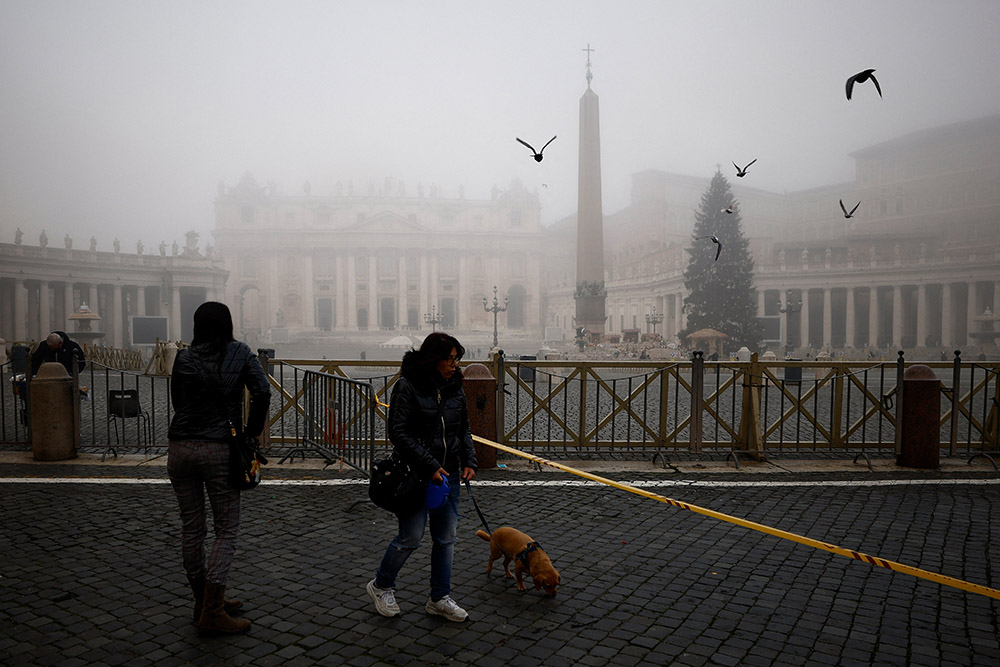
People walk near St. Peter's Square on a foggy day ahead of Pope Francis' celebration of Mass marking the feast of Mary, Mother of God, at the Vatican Jan. 1, 2022. (CNS/Reuters/Guglielmo Mangiapane)
Predictions are a fraught business, to be sure, but having looked back at 2021 last week, and specifically the divergence between the direction Pope Francis is taking and that chosen by the U.S. bishops' conference, we can expect that divergence to be the principal story in 2022. Will it grow? And if so, how will it grow? Or will the U.S. bishops at long last demonstrate an interest in following the lead of the Holy Father?
In his encyclical Fratelli Tutti, Francis wrote:
As I was writing this letter, the Covid-19 pandemic unexpectedly erupted, exposing our false securities. Aside from the different ways that various countries responded to the crisis, their inability to work together became quite evident. For all our hyper-connectivity, we witnessed a fragmentation that made it more difficult to resolve problems that affect us all. Anyone who thinks that the only lesson to be learned was the need to improve what we were already doing, or to refine existing systems and regulations, is denying reality.
These are not the words of a typical older man, settling in to cement his legacy. They are the words of the most disruptive 85-year-old in the history of the papacy. It seems that in 2022, Francis will put the pedal to the metal.
At long last, the expected reform of the Vatican Curia's constitution will be promulgated at some point this year. Less important than any particular provision is the extensive consultation that went into its preparation. That work has already helped bring about a change in the relationship between the Roman Curia and the universal church: Bishops on their ad limina visits were accustomed to getting yelled at by the curial officials, and now the visiting bishops report a more sympathetic reception.
Advertisement
If personnel is policy, we can expect the pope to continue with the appointment of new leaders to key dicasteries. The appointment of a new prefect of the Dicastery for Promoting Integral Human Development is not expected until the summer. Cardinal Kevin Farrell will reach 75 this year, but his mind is as sharp as a tack and he may stay on a few more years as prefect of the Dicastery for Laity, Family and Life. Cardinal Gianfranco Ravasi will turn 80 this year and so a new president for the Pontifical Council for Culture will be named. (I am available! LOL!)
The most important change, long overdue, is at the Congregation for Bishops. The process by which bishops are selected is still unnecessarily cumbersome because Cardinal Marc Ouellet has refused common-sense modifications. For example, when a terna (list of possible candidates) is approved and sent to the pope, one of the three candidates is selected. The other two have been vetted, so why are they not assigned to other vacant sees with similar needs? No, the whole process for the vacant sees must begin anew. That is madness.
Worse, many of the men selected to become bishops, at least in the U.S., do not exactly scream, "Wow, this is a Pope Francis guy!" More often, there is a collective "meh."
Perhaps the problem is at the nunciature. Perhaps it is in Rome. But the usual method of relying on suggestions from the current bishops, who in this country are not overwhelmingly supportive of the pope's agenda, and running the process through a congregation still led by a prelate not on board the pope's agenda either, is producing candidates who seem incapable of dynamic leadership in line with the direction indicated by Francis. Can anyone think of a bishop appointed in the past few years who, for example, has distinguished himself by creatively implementing Laudato Si'? Have any dioceses moved their plant to zero emissions?
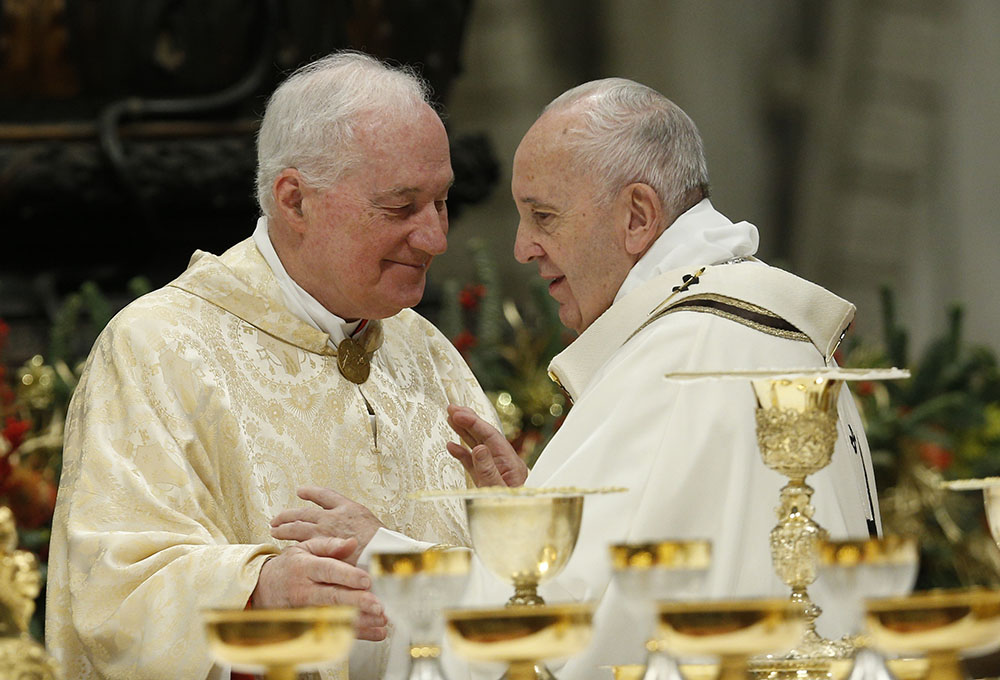
Pope Francis greets Cardinal Marc Ouellet, prefect of the Congregation for Bishops, during the sign of peace as he celebrates Mass marking the feast of the Epiphany in St. Peter's Basilica at the Vatican Jan. 6, 2020. (CNS/Paul Haring)
The pope needs to appoint a new prefect of the Congregation for Bishops who supports him, but also someone who, at least in regard to the U.S. bench, will insist on candidates capable of more dynamic support for the pope's call to continue implementing the Second Vatican Council.
That really is the point, isn't it? Some bishops, clergy and laypeople thought the reception of Vatican II was completed in the pontificate of St. Pope John Paul II. The new code of canon law, the catechism, the voluminous papal teaching, all certainly aimed at implementing the council. However, my church history mentor, the late Msgr. John Tracy Ellis, used to tell us that it takes 100 years to receive a council, not 40, so there remained work to be done when John Paul II went to his heavenly reward.
Francis was formed by the post-conciliar church of Latin America, which was home to the most pastorally and theologically fecund reception of any part of the universal church. It is clear that the approach that the Latin American bishops have developed and that Papa Bergoglio embodies does not sit well with many U.S. and Western European conservatives.
I would like to see more reporting on the degree to which his approach does, and does not, resonate with the experience of the church in Africa and Asia. After all, the church in Latin America formed a Catholic culture through the centuries, whereas the churches of Africa and Asia are young and newly evangelized, springing from a culture not defined by Catholic sensibilities. Surely there are significant points of convergence but also divergence. Yet, we do not hear of hostility to the pope in these other parts of the world, certainly not to the degree found in the U.S.
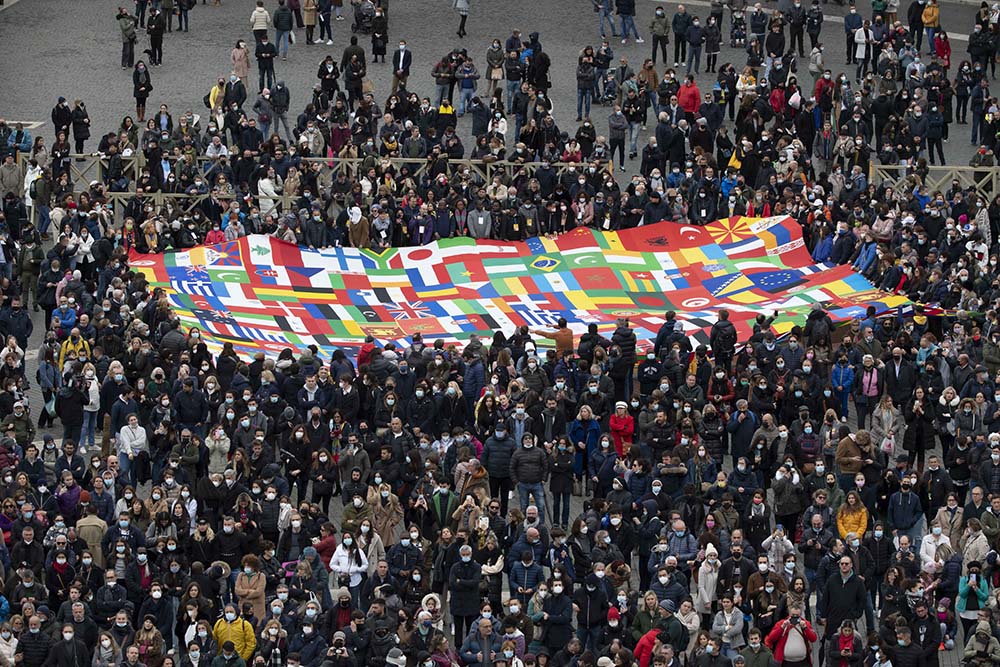
People in St. Peter's Square at the Vatican attend the Angelus led by Pope Francis from the window of his studio overlooking the square Nov. 28, 2021. (CNS/Vatican Media)
All such issues of the relationship of the church to the culture will be at the heart of the synodal process Francis has inaugurated. That process will continue to define the rest of this papacy and, God willing, the rest of the century of reception of the council.
Regrettably, at least in this country, there seem to be as many bishops signaling a desire to return to pre-conciliar ideas. How many bishops and archbishops have demonstrated no interest, or worse, in Traditionis Custodes? How many bishops have taken the bizarre step of placing a tabernacle back in the main sanctuary of their cathedrals, a configuration that made sense for the pre-conciliar liturgy, but not now? Why were seminaries teaching the Tridentine rite to students?
The bishops of the United States have three obvious opportunities in the new year to jump on board the Francis train. First, they can vigorously engage the synodal process and really listen to the people in the pews, not just to the people who write letters and whose profession is to be angry, but to the B+ Catholics who try not to miss Mass, value kindness to neighbors and generosity to strangers, understand the basics of Catholic morality. Maybe even the C+ Catholics who do miss Mass quite often but who also find themselves talking to God throughout the day, genuflect before going into a pew and worry about the commercialization of Christmas.
The second vehicle for reform by the bishops will be the decisions they will take regarding "Forming Consciences for Faithful Citizenship," the quadrennial document on voting. The current text was adopted in 2008 so it does not contain any of the magisterium of Francis or the social magisterium of Pope Benedict XVI. The prefatory notes are overlong and suffer from the same approach as the core text: a checklist mentality that may have once served the noble bureaucratic goal of forging unity among the body of bishops, but did so at the expense of the text's primary goal of instructing the faithful. No one reads the thing because it is too long.
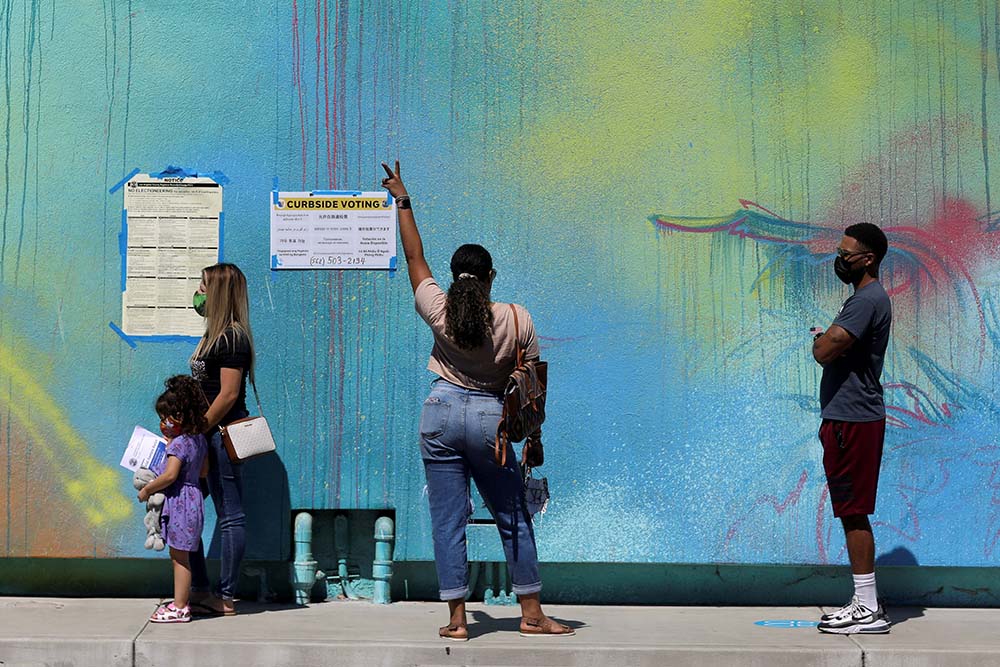
A woman in Long Beach, California, gestures as people wait to vote in the state's gubernatorial recall election Sept. 14, 2021, outside the Museum of Latin American Art. (CNS/Reuters/David Swanson)
The U.S. bishops should take a page, actually half of a page, from their brothers to the north. In Canada, the bishops issued a statement in advance of last September's parliamentary elections that was half of a page long. Perhaps the U.S. bishops could take a full page, maybe even two, seeing as democracy itself is being challenged and they need to stand up and defend it. But no more than two!
The deeper problem with "Faithful Citizenship," however, is that it still bears a clericalist imprint. It does not focus sufficiently on "forming consciences" but, instead, really leans in to telling laypeople how to vote. Politically active Catholics on both the left and the right still rely overmuch on statements from bishops, as if it was the bishops' responsibility to bring the Gospel into the world, when that task properly belongs to the laity.
No one document can undo ecclesial habits that have stuck with us since the days of the Catholic ghetto, when the bishop was a kind of local lord and the people in the pews were his serfs, but a new draft should move in that direction.
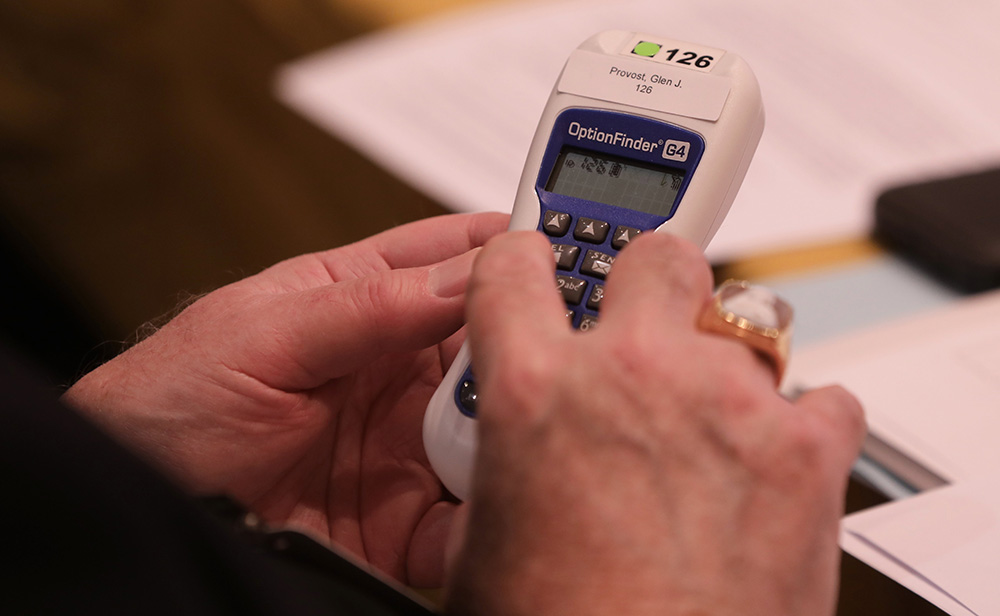
A bishop casts his vote during a Nov. 16, 2021, session of the fall general assembly of the U.S. Conference of Catholic Bishops in Baltimore. (CNS/Bob Roller)
The third means of effectuating reform and getting on board the Holy Father's agenda will come when the bishops elect new leadership in November. Usually, the incumbent vice president of the bishops' conference moves up to the top spot, but the current VP is Archbishop Allen Vigneron of Detroit, who will be 74 when the election is held in November. That does not preclude his becoming president of the conference, but when the pope accepts a bishop's resignation, all other posts, like being an officer of the conference, lapse as well.
Team Francis is within striking distance of a majority of the conference and if they do a little organizing, they could secure either the presidency or the vice presidency — or both. They would need a centrist candidate like Archbishop Mitch Rozanski of St. Louis or Archbishop Paul Etienne of Seattle. Both men lost elections this past November, but the margins were close — Rozanski only lost by a single vote! If the pope appoints a dozen new bishops this year and they are all on board, the tide could turn.
Another selection will indicate how determined the bishops are to align themselves with the pope. The presidency of the Catholic University of America will become vacant when John Garvey steps down at the end of the academic year. On his watch, the school has lurched to the right, and not to a respectable, Burkean conservative right, but to the libertarian right, with the establishment of a business school more committed to libertarian ideology than to Catholic social teaching.
It is a demanding job, and it would be impossible to appoint a liberal: The only money the school is getting is from the right, and the Catholic left is notoriously bad about funding the intellectual apostolate. A center-right Latino, preferably a priest or woman religious, would be ideal.
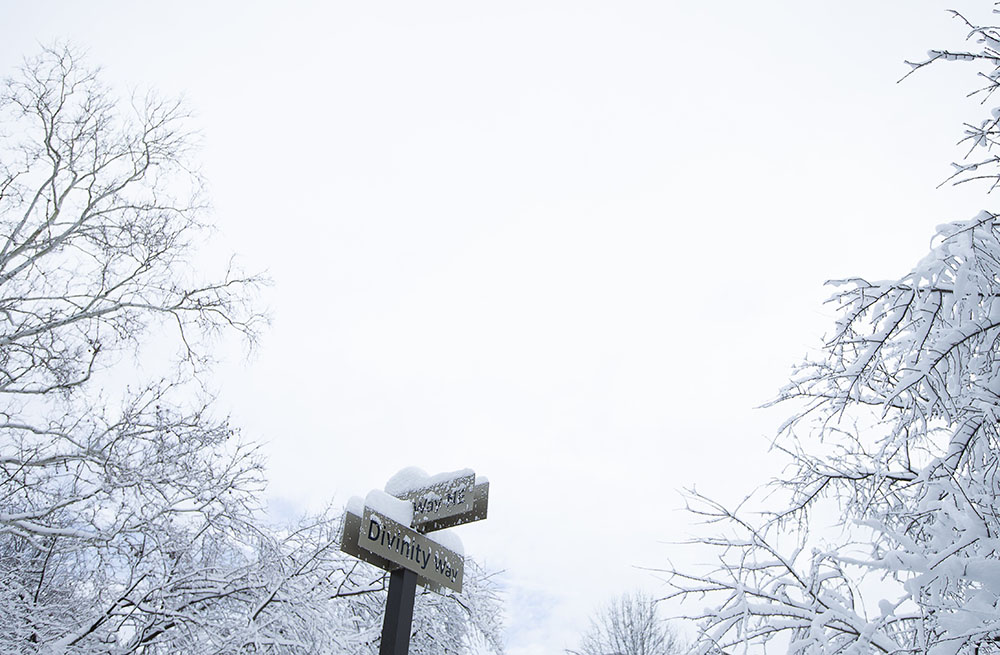
A street sign is seen on the campus of the Catholic University of America after a snowstorm in Washington Jan. 3, 2022. (CNS/Tyler Orsburn)
The pope also may introduce new dynamics in the U.S. church, not only through the appointments of new bishops but at a consistory, which seems likely in June or in the autumn. I would not expect any American to be raised to the purple, but if the pope decided to do so, he could confer a clear sense of priorities and direction by his choice. Mindful of Francis' preference for the peripheries, I would expect any new American cardinal to come from a diocese that has never had a cardinal before and probably from a border diocese as well.
As for the appointment of new bishops, Bishop Thomas Olmsted of Phoenix hits 75 this month, and he has been bishop of the fastest-growing city in the country since 2003. Turning that diocese away from his culture-warrior approach will not be easy. It will require someone from the center and with a winning personality, as well as committed to the vision of Francis.
The Archdiocese of Louisville, Kentucky, which witnessed inspiring leadership in the spirit of Vatican II during the tenure of Archbishop Thomas Kelly from 1982 until his retirement in 2007, offers the pope another opportunity to make a daring appointment and bring new life to a historic archdiocese.
These are the stories, then, that will dominate in the media, but I readily admit they give a distorted perspective on the church as a whole. The great Swiss theologian Hans Urs von Balthasar reminded us that the church's most essential forces are "prayer, suffering, faithful obedience, readiness (perhaps unexploited), humility," and these will be manifest in the lives of the people in the pews as well as in the life of the pope.
The great reform of the Middle Ages began when St. Francis first kissed a leper. Whether or not the reforms of his namesake take greater hold in the United States will be a story of the activity of the Spirit, notoriously difficult to chronicle. We in the press will only report the fluttering of the leaves as the Spirit passes. But I predict 2022 will yield some big leaf-shaking events!




